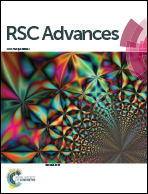Bioinspired preparation of monolithic ordered mesoporous silica for enrichment of endogenous peptides†
Abstract
In the current study, monolithic ordered mesoporous silica (MOMS) was successfully prepared by a modified Stöber method using natural pomelo peel and cetyltrimethylammonium bromide (CTAB) as dual templates. A mesostructured CTAB/silica composite was deposited on the carbohydrate-based surface of the sponge-like pomelo peel. After removing the templates by calcination and acid treatment, MOMS with a continuous skeleton, interconnecting macropores and ultra-high surface area (1120 m2 g−1) was obtained. MOMS materials with various and controllable sizes and shapes could be prepared simultaneously in a one-pot synthesis. Small pieces of MOMS (millimeter size) were then applied as the adsorbent to enrich peptides. Owing to the ordered mesoporous structure, the as-prepared MOMS was demonstrated to be an excellent adsorbent for effective enrichment of endogenous peptides from human plasma.


 Please wait while we load your content...
Please wait while we load your content...